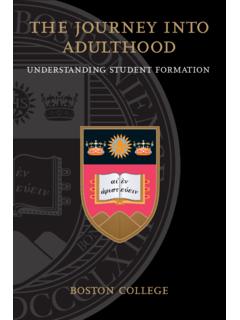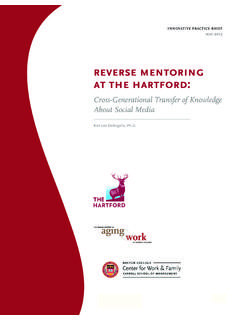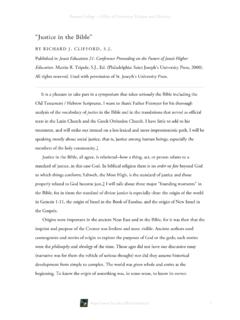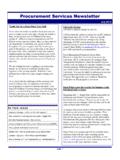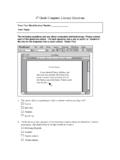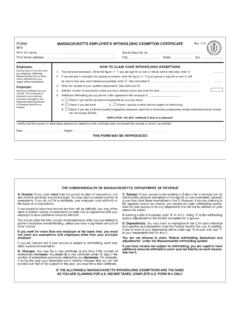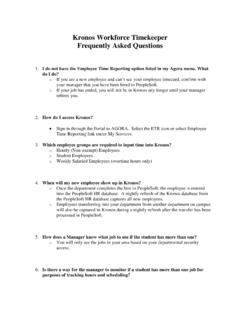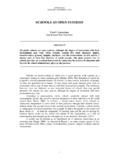Transcription of age & generations - Boston College
1 Research highlight 6 research highlight 6. march 2009 march 2009. age & generations : Understanding Experiences at the Workplace Marcie Pitt-Catsouphes, , Christina Matz-Costa, and Elyssa Besen introduction In response to recent shifts in the age composition of the workforce, employers have started to raise questions about whether age is related to employees' experiences at work. Employers can use their understanding about age and generational differences to enhance the effectiveness of their talent management policies and practices for to- day's multi-generational workforce. Although a new understanding about generational issues has started to emerge, a considerable amount of misinformation has also prolif- erated.
2 W. Stanton Smith gets to the heart of the matter with the title of his 2008 book, Decoding generation Differences: Fact, Fiction or Should We Just Get Back to Work? 1. The Age & generations Study conducted by the Sloan Center on Aging & Work at Boston College was designed and implemented in collaboration with forward-thinking employers to gather information about contemporary multi-generational work teams. This Research Highlight presents selected findings of this study that have relevance for strategic human resource decision making. We address the following questions: Do the perceptions maintained by workers of different ages/ generations about the quality of their jobs and employment situations vary?
3 Do these perceptions vary depending on whether employees are in the early, middle, or late part of their careers? Are the perceptions of employees with different life course experiences (that is, those with and without dependent care responsibilities) similar or different? How do employees with different amounts of tenure with their current em- ployers assess the quality of their employment experiences? This report is organized into three sections. First, we present some information about three different ways in which to group employees: age/ generation , career-stage, and life course. Because tenure is often related to age, we also discuss groups according to tenure.
4 Next, we provide an overview of some of the ways that we measure the quality of employment. Finally, we discuss the similarities and differences in the employment experiences of the members of these different groups. 1. table of contents Introduction 1 Age/ generations , Career-Stage, Life Course and Tenure: Maybe More than Meets the Eye 4. Quality of Employment: Overview 7. Quality of Employment: Comparing Employees of Different Ages/ generations 15. Quality of Employment: Comparing Employees in Different Career-Stages 16. Quality of Employment: Comparing Employees in Different Dependent Care Groups 17.
5 Quality of Employment: Comparing Employees with Different Years of Tenure 18. Conclusion 19. The Age & generations Study at a Glance 20. Appendix A-1: Quality of Employment Dimensions by Ages/ generations 23. Appendix A-2: Quality of Employment Dimensions by Career-Stage 28. Appendix A-3: Quality of Employment Dimensions by Dependent Care Groups 32. Appendix A-4: Quality of Employment Dimensions by Tenure Groups 36. Acknowledgements: The Sloan Center on Aging & Work is grateful for the generous support of the Alfred P. Sloan Foundation for the Age & generations Study, as well as other Center proj- ects.
6 We also want to express our appreciation for the patient assistance offered by the 12 worksites that collaborated with us to make this study a success. The research team for the Age & generations Study included (in alphabetical order): Elyssa Besen, Javier Boyas, Jackie James, Kathy Lynch, Christina Matz-Costa, Marcie Pitt- Catsouphes (Co-Principal Investigator), Michael Smyer (Co-Principal Investigator), Jennifer Swanberg, and Monique Valcour. 2 research highlight 6. march 2009 Selected Findings Among the employees who participated in this study, we discovered that: Millennials/ generation Y'ers (ages 26 or younger) had significantly lower work overload (were less overloaded by their work) scores than generation X'ers (ages 27 to 42) and Baby Boomers (ages 43 to 61).
7 Millennials/ generation Y'ers (ages 26 or younger) and the Younger Gen- eration X'ers (ages 27 to 35) were less likely to say that their work is full of meaning and purpose than the Baby Boomers (ages 43 to 61) and the Tradi- tionalists/Silent generation (ages 62 or older). Older Baby Boomers (ages 53 to 61) perceived lower supervisor support compared to generation X'ers (ages 27 to 42) and the Younger Baby Boom- ers (ages 43 to 52). Millennials/ generation Y'ers (ages 26 or younger) reported greater oppor- tunities for learning and development compared to Older generation X'ers (ages 36 to 42).
8 The mid-career group felt that they had greater access to the flexible work options needed to fulfill their work and personal needs compared to the early- and late-career groups. Employees providing eldercare reported less access to the flexible work options needed to fulfill their work and personal needs compared to those employees providing childcare or those with no dependent care at all. Employees with 0-3 years of tenure had more access to flexible work options than did those with years of tenure; however, those with to 10. years used a greater percentage of the options available to them than did those with 0-3 years of tenure.
9 Technical Note: The findings presented throughout this report were weighted so that each organization in the sample was equally represented in the dataset. 3. age/ generations , career-stage, life course and tenure: maybe more than meets the eye When considering age and work, it can be a bit difficult to untangle what is related to what because age is often connected to many aspects of our lives. For example, there is often a correlation between age, career-stage, life course, and tenure; however, it is important to keep the distinctions clear. Chronological age is often used as proxy measure for age-related individual human de- velopment (physical, social, emotional, and cognitive).
10 In recent years, it has become common for practitioners at the workplace to use the language of generations when discussing age groups. This is in part because it can be easier to keep the idea of a generation group in our minds than, for instance, a 10-year age range, such as employ- ees between the ages of 25 and 34. The term generation refers to a group of people who are approximately the same age. Key societal experiences (such as economic circumstances, historical events, and dominant cultural values) have the potential to affect the many ways that a majority of the members of these groups view the world and find meaning in their experiences.
